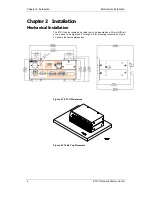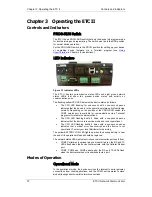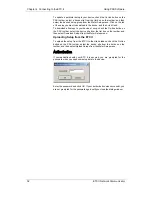
Chapter 3 Operating the ETC II
Using the ETC II
ETC II Network Communicator
17
Data Server
The ETC II has an embedded Data server that allows the user to save time
required for polling multiple devices, especially via slow serial interfaces. It
utilizes the ETC II non-volatile memory for automatic data acquisition.
The Data server is accessible via the Modbus/TCP protocol from any remote
application. The user application can read blocks of ready data directly from
the ETC II memory exchanges without the need to wait until slow devices
respond to master requests.
The Data server can also perform a delayed write of data so the application
does not need to wait until the device is accessible, but rather can write data
to the ETC II memory exchanges, with the ETC II then taking responsibility
for delivering data to the target devices.
The Data server can also periodically poll device status registers, record
events to a log file and give alerts on specific events.
The following table gives a summary of the available data exchanges.
Exchange Type
Number
of
Exchanges
Exchange
Block
Size, registers
Real-time data exchange
250
1-114
Status event exchange
250
1
Data write exchange
250
1-12
NOTE:
The real-time, status event and write data exchanges with the same
exchange number are internally linked in the ETC II to the same device
address. If you change the device address for one of the exchanges, the
same address will be taken for other configured exchanges that have the
same exchange number.
See
Configuring Data Server
in Chapter 5 for information on configuring
data exchanges. Refer to the ETC II Modbus Guide for information on
accessing and retrieving data from the Data server exchanges.
Real-Time Data Exchanges
Real-time data exchanges are used for periodic retrieval of data from the
connected devices. The ETC II provides up to 250 real-time data exchanges
of 1 to 114 registers long. They are directly accessible from remote master
applications.
When the Data server is enabled, it acquires data from the connected
devices either continuously, or on a periodic basis. If continuous polling is
disabled, the devices are requested periodically at predefined poll intervals.
If continuous polling is enabled, the ETC II retrieves data from the devices in
turn without pauses.
You can individually enable or disable polling data for a specific exchange. If
the device has an onboard real-time clock, you can enable periodic RTC
updates from the ETC II clock, which may be synchronized with the precise
satellite GPS clock using an optional IRIG-B input.
Acquired real-time data is normally stored in the ETC II exchanges. If the
user wishes, acquired data can be periodically moved to historical circular
files where data is kept for a long time until it is overwritten by newer data.
Data is recorded to historical files at regular intervals. To enable logging,
specify a non-zero logging interval in the Data Server Options setup (see
Configuring Data Server
in Chapter 5). The logging interval is always
represented as a whole number of data polling intervals even if the polling
itself is not synchronized with polling intervals, such as in the event of
continuous polling. Since the ETC II attempts to synchronize polling devices
with the beginning of an hour, it is recommended to program a logging
interval in such a manner that it is a whole divisor of 60 minutes.
















































